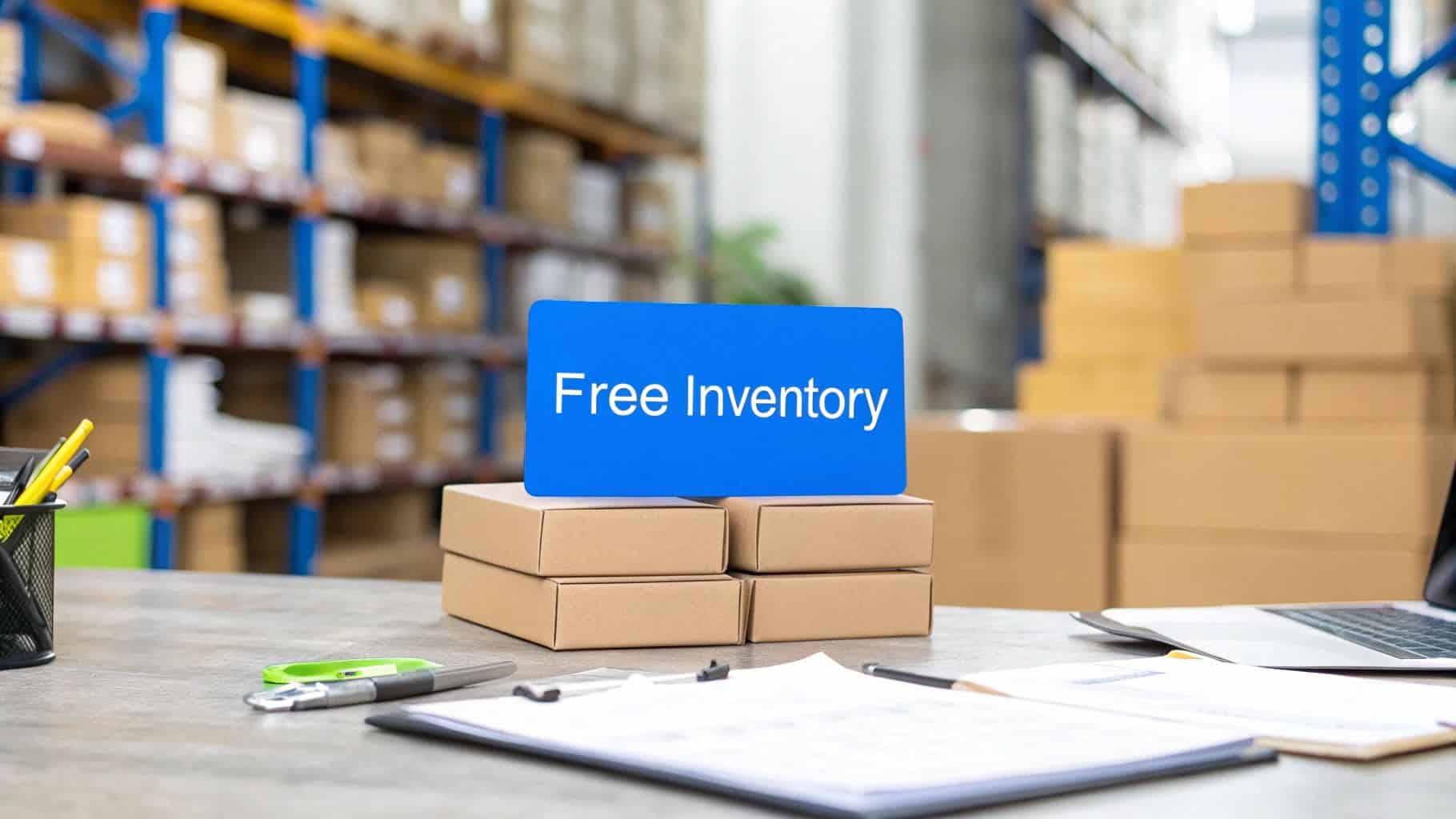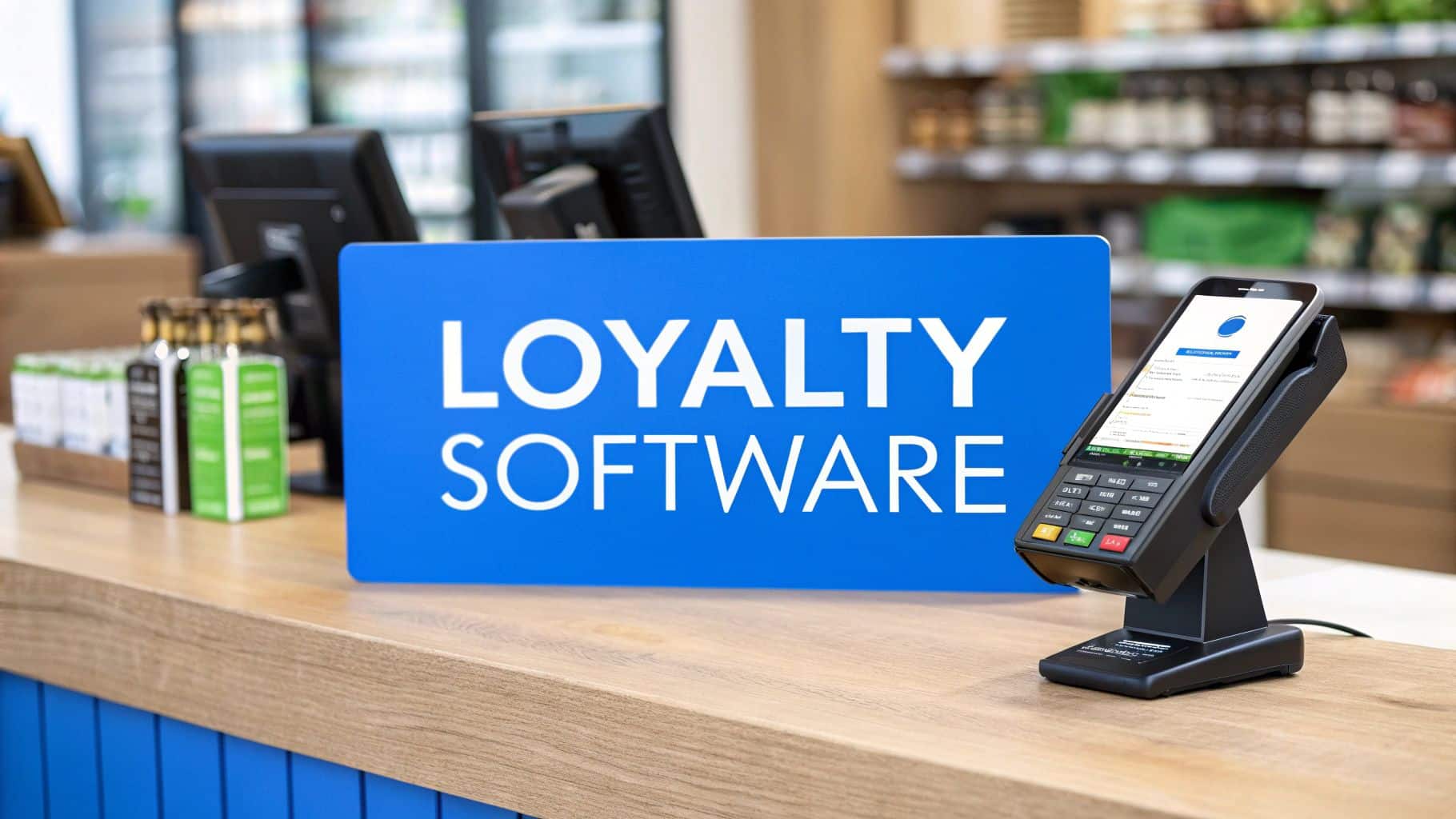Finding the best free inventory management software isn't a one-size-fits-all situation; it really depends on what your business needs right now. Still, a few names consistently rise to the top, like Zoho Inventory, Square, and Odoo. These platforms offer surprisingly capable free plans that help small businesses finally ditch the spreadsheets without spending a dime.
Finding Your Ideal Free Inventory Software

If you're running a small business or a startup, you know that stock control is a delicate balancing act. Tie up too much cash in inventory, and you starve other parts of your business. But run out of a popular item, and you're looking at lost sales and unhappy customers. This is precisely where a good inventory system stops being a "nice-to-have" and becomes a necessity.
Making the leap from a manual spreadsheet to an automated system is a game-changer. The right free tool gives you the essential functions to keep your counts accurate and your operations smooth, all without touching your budget. If you want to get a better handle on the basics, our guide on what is inventory management software is a great place to start.
What to Expect from Free Platforms
Let's be realistic—free software comes with a few strings attached. Most free plans have built-in limits designed to nudge you toward a paid plan as your business grows. You'll often run into caps on things like:
- The number of monthly orders or sales you can process.
- How many users can be on the system at once.
- The total number of SKUs (individual items) you can track.
- The number of warehouses or physical locations you can manage.
Even with these limitations, the features you get are often more than enough to build a solid foundation for inventory control and get your processes in order.
The real goal of a free inventory tool is to deliver immediate value. It helps you stop costly mistakes like overselling and gives you a clear picture of your operations, setting you up with good habits that will serve you well as you scale.
To give you a head start, I've put together a quick comparison of the top contenders. This table breaks down who each platform is best for, its standout free feature, and the main limitation you should be aware of.
Top Free Inventory Management Software At a Glance
| Software | Ideal For | Standout Free Feature | Key Free Plan Limitation |
|---|---|---|---|
| Zoho Inventory | E-commerce Startups | End-to-end order management | Capped at 50 sales orders per month |
| Square | Retail & Restaurants | Unlimited items & locations | Must use Square for payment processing |
| Odoo | Growing Businesses | All-in-one business apps | Free app hosting only (no support) |
This at-a-glance view should help you quickly narrow down which tools might be the right fit before diving into the more detailed reviews.
Why Smart Inventory Management Is Non-Negotiable
In a world where customers can buy anything with a few clicks, managing your stock is no longer a simple back-office chore. It's the engine that drives your entire operation. A basic spreadsheet just can't keep up anymore. Today's shoppers expect a flawless experience, whether they're buying online, in-store, or picking up curbside, and they want their orders fast.
This new reality makes real-time visibility into your inventory an absolute must. Without it, you’re flying blind. You risk overselling your most popular items, which leads to canceled orders and unhappy customers. On the flip side, you could end up with a warehouse full of dead stock, tying up cash that could be used to grow your business.
The Evolution From Manual To Automated Systems
Making the jump from a manual tracking system to automated software is a game-changer for any business. Spreadsheets are a decent starting point, but they’re notoriously prone to human error and can’t deliver the instant updates you need when selling across multiple channels. Modern inventory software, especially cloud-based tools, solves these headaches directly.
What was once reserved for massive corporations is now accessible to everyone. Even the best free inventory management software gives small businesses the power to slash costs, boost customer happiness, and scale effectively. Of course, the software is only as good as your strategy, so it’s crucial to implement proven inventory management best practices.
The market growth tells the story. Valued at roughly USD 2.38 billion in 2025, the global inventory management software market is expected to explode to USD 8.48 billion by 2035. That's a compound annual growth rate of 13.1%, proving just how essential these tools have become.
An intelligent inventory system does more than just count products; it provides the data-driven insights needed for smarter purchasing decisions. It helps you understand sales velocity, identify slow-moving items, and anticipate future demand with greater precision.
Driving Efficiency And Customer Satisfaction
Ultimately, smart inventory management is about building a more profitable and resilient business. It helps you prevent stockouts, get orders out the door faster, and keep your financial records accurate. By automating the tedious day-to-day tasks, you and your team can focus on what really matters—building your brand and delighting your customers.
Good data is also the bedrock of smart planning. When you truly understand your inventory patterns, you can make much better decisions about what to order and when. Our guide on mastering inventory forecasting techniques dives deep into turning that data into a predictive powerhouse. This proactive approach ensures you have the right products on your shelves at exactly the right time.
Comparing The Best Free Inventory Platforms
Picking the right free inventory tool means digging into the details, not just sales pitches. Even if a plan is “free forever,” its true value depends on your unique setup. What works for a solo Etsy seller can falter for a multi-location café.
We’ll examine three heavyweights—Zoho Inventory, Square, and Odoo—. Our focus: order limits, user seats, integration scope, and standout capabilities. By the end, you’ll see which solution aligns best with your daily operations.
These figures reveal trade-offs. Robust feature sets often come with tighter caps, while open ecosystems demand more hands-on setup.
Zoho Inventory For E-Commerce Startups
Zoho Inventory caters to online sellers who need a seamless order-to-shipment workflow. It integrates neatly with Shopify, Etsy, and Amazon, so you can centralize your sales channels in one dashboard.
Key limits on the free plan include:
- 50 Sales Orders Per Month
- One Warehouse Location
- Two User Seats
Plus, you get shipping integrations with major carriers. If you’re in launch mode and processing modest volume, Zoho’s free tier brings professional-grade order tracking without overwhelming fees.
Square For Retailers And Restaurants
Square ties its inventory tools directly into its POS and payments stack. If you’re already swiping cards through Square terminals, adding inventory management costs you nothing—and unlocks:
- Unlimited Items, Users, and Locations
- Real-Time Stock Counts and Restock Alerts
- Built-In Reporting Within the POS Interface
To tap these perks, you must use Square for all payment processing. If you rely on another gateway, this closed-loop can become a deal-breaker.
For cafés, boutiques, or pop-up shops focused on face-to-face sales, Square’s ecosystem offers frictionless, unified data.
Odoo For All-In-One Business Management
Odoo shines with its modular, open-source framework. The free Community Edition’s inventory app delivers:
- Advanced Warehouse Routing
- Double-Entry Stock Movements
- Custom Reporting Tools
On the flip side, you’re in charge of hosting, updates, and support. That means more flexibility but also a need for technical resources. Growing teams that want full control over workflows and integrations will appreciate Odoo’s depth.
Feature Breakdown Of Leading Free Inventory Software
Before you dive deeper, here’s a side-by-side glance at the essentials:
| Feature | Zoho Inventory | Square | Odoo |
|---|---|---|---|
| Order Limit | 50 per month | Unlimited | Unlimited |
| User Seats | 2 Users | Unlimited | Unlimited |
| Integrations | Strong (E-Commerce) | Limited (Square Only) | Extensive (API) |
| Unique Capability | End-to-End Order Flow | Integrated POS & Payments | Full Business Suite |
This snapshot highlights where each platform shines—and where they ask you to adapt. Use it as a starting point, then track your real-world workflows against these strengths to find your perfect match.
Finding the Right Software for Your Business
Picking the best free inventory management software isn’t about chasing the longest feature list. It’s about finding a tool that genuinely solves your day-to-day problems. What works for an online artisan selling handmade goods is entirely different from what a bustling coffee shop needs to keep track of its cups and beans.
The best way to see which tool fits is to look at real-world situations. Let's walk through a few common business types to see how these free platforms would actually perform on the ground. This will help you see past the marketing and choose what’s truly right for you.
For the Online Marketplace Seller
Picture an Etsy seller who also has a storefront on Shopify. Their biggest headache? Overselling. If a unique, one-of-a-kind necklace sells on Etsy, the Shopify listing needs to vanish immediately—and vice versa. This all comes down to flawless multi-channel sync.
In this case, Zoho Inventory is a perfect match. Its free plan was built with e-commerce in mind, offering out-of-the-box integrations with major players like Etsy and Shopify. This lets the seller see and manage all their orders and stock from one central place, keeping inventory counts accurate across every channel without lifting a finger.
The game-changer for any e-commerce business is native integration. When a tool automatically syncs with your stores, it doesn't just save you hours of manual data entry; it prevents the customer frustration that comes from selling an item you no longer have.
For the Small Retail Shop or Cafe
Now, let's think about a local boutique or a corner cafe. Their world revolves around the point-of-sale (POS) system. Every time a customer buys a dress or a latte, the inventory count needs to update instantly and accurately.
Here, Square is the undeniable frontrunner. Because its inventory management is baked right into its POS, the connection is seamless. A shop already using Square to take payments gets a robust inventory tool with unlimited items and locations for free. For a deeper dive, check out our guide on the best retail POS software with built-in inventory management.
For the Service Business or Manufacturer
Finally, what about a service business, like an HVAC company that needs to track spare parts for its vans? Or a small-scale manufacturer juggling raw materials and finished products? They need more than a simple stock counter; they need to track components, assemblies, and production stages.
This is where Odoo really shines. Its free, open-source inventory app is surprisingly powerful, offering advanced features like double-entry inventory management. This creates a complete audit trail for every single item's movement, from raw material to finished product. This detailed tracking is essential for anyone managing complex supply chains, giving them tight control over their entire operation. This move toward more sophisticated systems is a major global trend; in fact, North America alone currently holds a 35.93% share of the inventory software market. You can find more details about the growing inventory software market on fortunebusinessinsights.com.
What to Look for in a Great Free Inventory Tool
When you start digging into free inventory management software, it's easy to get lost. You need to look past the simple promise of "free" and focus on the features that will actually help you run your business, not just count what's on the shelf. The right tool can prevent costly mistakes and give you back valuable time.
First and foremost, think mobile. Specifically, barcode scanning support. Being able to grab your smartphone, scan an item as it comes in the door, or pick an order without a clunky manual process is a game-changer. It slashes data entry errors and speeds everything up. A solid free tool will have a functional mobile app that makes this happen.
Next up are automated low-stock alerts. Nothing kills momentum like running out of a bestseller. The best free platforms let you set custom reorder points for your products, so you get a heads-up when stock is running low. This simple feature is the difference between proactive management and scrambling to recover from a stockout.
Don't Overlook Reporting and Integrations
Even a free tool needs to give you good data. Without it, you're just guessing. At a minimum, look for the ability to pull reports on sales velocity (how fast your products are moving) and inventory valuation (how much cash you have tied up in stock). These two reports alone can completely change how you make purchasing decisions.
Also, remember that your inventory system doesn't live on an island. It has to talk to the other software you use. That's where integration potential becomes critical.
- E-commerce Platforms: If you sell online, you need a direct link to your store on Shopify or WooCommerce. When a sale happens, your inventory levels should update instantly to prevent overselling.
- Accounting Software: A sync with tools like QuickBooks is a lifesaver. It keeps your sales data and inventory costs perfectly aligned, making bookkeeping far less painful.
The true test of a free tool is its ability to grow with you. Always look at the upgrade path. If the paid plans don't offer the features you'll need down the road—like multi-warehouse support or batch tracking—you're just setting yourself up for a painful migration later.
Thinking About the Future: Scalability and Market Trends
Think of your free plan as the first step, not the final destination. A clear and reasonably priced upgrade path is essential. As your business expands, you want your software to keep pace without forcing you to start from scratch with a whole new system.
This idea of scalability is a huge driver in the industry. The inventory management software market is already big—valued at an estimated USD 3.69 billion in 2024—and it's projected to hit USD 8.69 billion by 2033. Cloud-based tools are at the heart of this growth, making powerful inventory management accessible to everyone. You can find more details on the inventory management software market growth on mordorintelligence.com.
Answering Your Questions About Free Inventory Software
Jumping into the world of free inventory software can feel a bit confusing. It's smart to look past the "free" price tag and really dig into how these tools work, what their limitations are, and whether they can actually support you as your business grows. Getting straightforward answers to your questions is the best way to choose a platform you won't regret later.
Are Free Inventory Management Solutions Truly Free?
Yes, the tools we’ve covered here have genuinely free-forever plans, not just limited-time trials. But let's be realistic: "free" always has its limits. These plans are strategically capped to nudge growing businesses toward a paid subscription once they hit a certain scale.
Think of it as a starter kit. You'll almost always run into ceilings on things like:
- Monthly Orders: A maximum number of sales orders you can process each month.
- User Seats: Usually just one or two team members can have access.
- SKUs: A cap on the total number of unique products you can manage.
- Warehouse Locations: Typically, you’re limited to a single physical location.
The strategy for these software companies is pretty clear. They give you enough runway to get your operations in order. Then, as your business takes off and you start bumping into those limits, upgrading to a paid plan feels like the natural next step.
When Should I Upgrade From a Free Plan to a Paid One?
The tipping point comes when the free plan’s restrictions start costing you more in wasted time and missed opportunities than the paid plan would cost in dollars. If your team is spending hours patching together manual workarounds just to get by, that’s your sign.
A few common triggers tell you it's time to pull out the credit card:
- You're consistently hitting your monthly order or transaction limit.
- Your team is growing and you need to give more people access to the system.
- You're ready to open a second retail store or warehouse.
- You need more advanced features, like serial number tracking for electronics, batch tracking for perishables, or the kind of deep analytics that are always locked behind a paywall.
Upgrading isn't just another expense—it's an investment in your own efficiency. When the friction from a free plan's limits starts to slow you down, moving to a paid tier almost always delivers an immediate return on productivity.
Can Free Inventory Software Integrate With My E-commerce Store?
This is one of the biggest differentiators you'll find among the best free inventory management software. Most free options offer at least a basic connection to major e-commerce platforms like Shopify or WooCommerce, or marketplaces like Etsy. For many businesses, automating this link is the whole point.
However, the depth of these integrations is often where the free plans fall short. For instance, a free plan might let you sync with one online store but demand an upgrade to connect multiple sales channels at once. Before you commit, always, always verify which specific integrations are included in the free package to make sure they fit your current setup. This one small step can save you from a massive headache down the road.
For businesses looking for a seamless, all-in-one solution, Biyo POS combines powerful inventory management directly with its point-of-sale system. This integration eliminates the need for separate tools, providing real-time stock updates, sales tracking, and customer management in a single, intuitive platform designed to help you grow. Learn more and start your free trial at biyopos.com.







